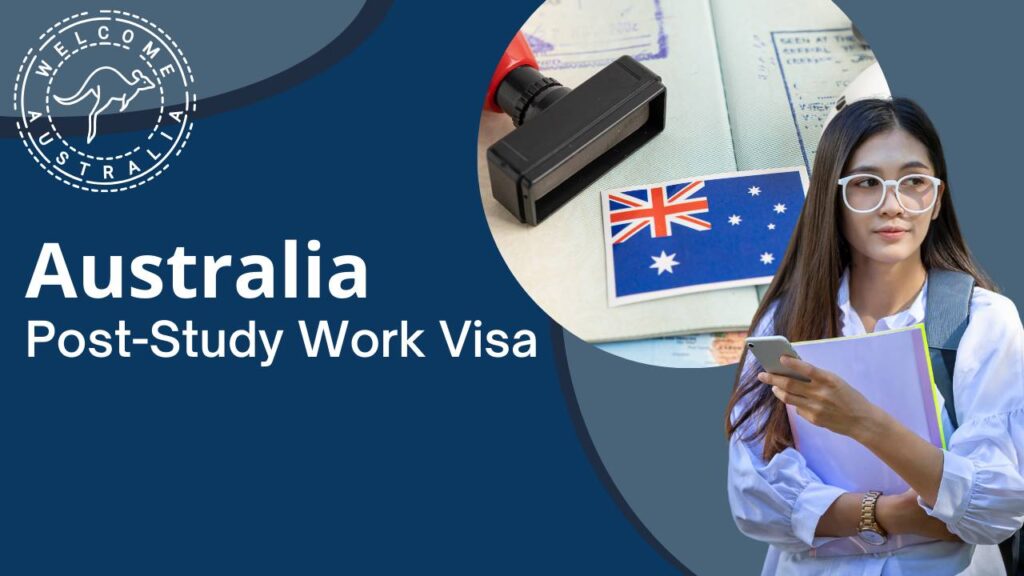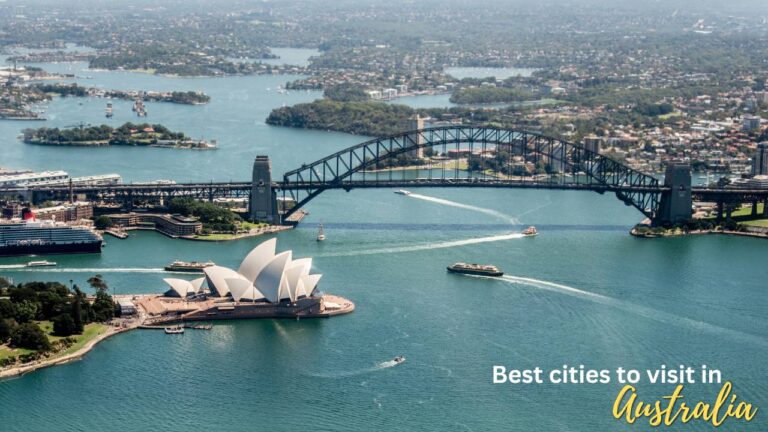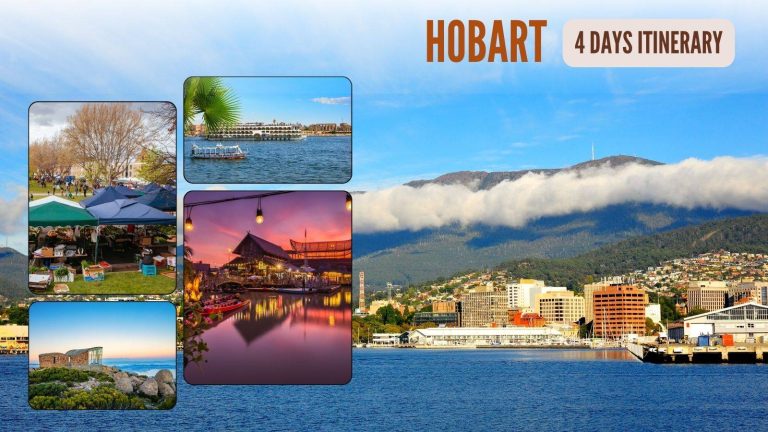For years, Australia has remained one of the top destinations for international students, not only for its high-quality education but also for the practical immigration options it offers post-graduation. Among those options, the post-study work visa Australia—officially known as the Temporary Graduate Visa (subclass 485)—has been one of the most important tools allowing international students to stay, work, and build a career after finishing their degrees.
In 2025, the Australian Government rolled out major updates to the 485 visa, focusing on tighter criteria but also offering more targeted pathways for students in critical sectors and regional areas. These changes are aligned with Australia’s 2024–25 Migration Strategy, which emphasizes economic needs, population management, and a skilled workforce for long-term growth.
What is the Post‑Study Work Visa (Subclass 485) in Australia?
The Temporary Graduate Visa (subclass 485) allows eligible international graduates to live, study, and work in Australia temporarily after they have completed a degree from a recognized Australian institution. It offers a critical transition phase for graduates, enabling them to gain local work experience and, in many cases, become eligible for permanent residency.
The visa includes two major streams:
- Graduate Work Stream: Designed for students with trade or diploma qualifications closely related to an occupation listed on the Skilled Occupation List (SOL). This stream mainly benefits those with hands-on skills needed in Australia’s workforce.
- Post-Higher Education Work Stream: Targeted at graduates who have completed a Bachelor’s, Master’s, or PhD degree from a CRICOS-registered Australian institution. This stream is not limited by occupation and is open to a broader range of students.
Both streams have seen structural changes in 2025, particularly in eligibility, age limits, stay durations, and priority processing, making the visa more streamlined and focused on national interest.
Key 2025 Updates: Everything You Need to Know
1. Age Limit Reduced to 35
As of July 1, 2024, the maximum age to apply for the 485 visa has been reduced from 50 years to 35 years. This is part of a broader effort by the government to manage the intake of international graduates and align the skilled migration intake with the labor market’s long-term needs.
While this change may affect mature-age graduates, it brings the policy in line with international standards and reflects the need to prioritize younger, long-term skilled workers. Notably, exceptions apply to Hong Kong and British National Overseas (BNO) passport holders, who can still apply up to age 50. Similarly, research-focused Master’s and PhD graduates may also be considered under relaxed criteria, especially if working in priority sectors like healthcare, engineering, or IT.
2. Updated Stay Durations Based on Qualification & Sector
One of the most significant updates in 2025 is the restructuring of stay durations under the Post-Higher Education stream. The number of years you can stay in Australia after graduation now depends both on your qualification level and whether you studied in a regional area or a priority sector.
| Qualification | Standard Stay Duration | Extended Stay in Priority/Regional Areas |
|---|---|---|
| Bachelor’s Degree | 2 years | Up to 4 years |
| Master’s Degree (Coursework) | 2 years | Up to 4 years |
| Master’s Degree (Research) | 3 years | Up to 5 years |
| Doctoral Degree (PhD) | 4 years | Up to 6 years |
This restructure encourages students to pursue high-need qualifications and promotes education in regional campuses, where there are greater skills shortages. Those who graduate from Designated Regional Areas may qualify for an additional 1–2 years of visa extensions under a second post-study work visa.
This new tiered structure is aimed at attracting young, skilled talent who can support Australia’s labor needs in rural, health, and digital transformation sectors.
3. Faster Processing Times with a 21-Day Service Target
The Department of Home Affairs has made major improvements to the visa processing infrastructure in 2025. Thanks to digital automation, increased staffing, and system optimization, the Post-Higher Education stream now has a service standard of 21 days.
This means that graduates who submit accurate and complete applications can expect decisions in under a month, compared to previous wait times of 2–3 months or more. The Graduate Work stream also benefits from faster timelines, especially for applicants with qualifications in critical occupations such as nursing, aged care, education, and IT.
The faster processing is a welcome relief for students awaiting their next steps, allowing them to secure employment, housing, and stability in a much shorter timeframe.
4. Visa Fees Increased in 2025
As of February 1, 2025, the base application charge for the Temporary Graduate Visa (subclass 485) was increased to AUD $1,895 for the main applicant. Dependents are charged additional fees, with adult dependents costing approximately AUD $950 and child dependents AUD $475.
While this fee hike may place financial pressure on some applicants, the government justifies the increase as part of the “user-pays” model aimed at covering the cost of immigration processing, health screening, and compliance activities.
Students should plan their budget accordingly and ensure they include visa fees, health insurance (OVHC), and English test fees when preparing their post-study transition.
Who is Eligible for the Post‑Study Work Visa in 2025?
To qualify for the updated post-study work visa Australia in 2025, international graduates must meet the following eligibility criteria, which have been refined to ensure that the visa supports skilled graduates and aligns with Australia’s labor market needs.
1. Be Under 36 Years of Age at the Time of Application (Unless Exempt)
Applicants must be under 36 years old when they lodge their application. This age limit is a part of the recent reforms to ensure younger, skilled talent contributes to the workforce.
Certain exemptions may apply for specific visa holders or under government-endorsed pilot programs. Age waivers might also be considered for Ph.D. holders or regional graduates in high-demand sectors. Always check the latest guidelines to see if you qualify for any age-related exemptions.
2. Have Held a Valid Student Visa (Subclass 500) Within the Last Six Months
You must have been a primary holder of a valid Subclass 500 Student Visa within the last 6 months prior to applying. This ensures a seamless transition from study to work, giving recent graduates the opportunity to gain valuable experience in Australia.
If your student visa has expired, you must apply while holding a bridging visa or other eligible temporary visa, and your last substantive visa must have been the Student Visa (Subclass 500).
3. Have Completed a CRICOS-Registered Course That Meets the Australian Study Requirement
Your qualification must be obtained from a course that is registered under the Commonwealth Register of Institutions and Courses for Overseas Students (CRICOS).
To meet the Australian Study Requirement, the course must:
- Be at least 92 weeks in duration, typically equating to two academic years.
- Be delivered in English.
- Have been undertaken while physically in Australia on a valid student visa.
This rule ensures that international graduates are genuinely contributing to the Australian education sector and workforce readiness.
4. Provide Evidence of English Language Proficiency
Applicants are required to demonstrate English language proficiency, typically through one of the following tests:
- IELTS: Minimum overall score of 6.0, with no individual band less than 5.0.
- TOEFL iBT, PTE Academic, Cambridge C1 Advanced, or OET are also accepted alternatives.
This requirement guarantees that visa holders can effectively communicate and integrate into Australian workplaces and communities. Note that citizens from certain English-speaking countries (like the UK, USA, Canada, NZ, and Ireland) may be exempt from this requirement.
5. Pass Standard Health and Character Checks
All applicants must undergo health and character assessments to ensure they meet Australia’s visa integrity standards:
- A health examination is mandatory to confirm you don’t pose a public health risk.
- A police clearance certificate from every country where you’ve lived for 12 months or more in the last 10 years is required.
- Applicants must not have any substantial criminal records or adverse immigration history.
These checks are crucial for ensuring community safety and the integrity of Australia’s migration system.
6. Maintain Valid Overseas Visitor Health Cover (OVHC) Throughout the Visa Duration
You must show proof of adequate health insurance coverage through an approved Overseas Visitor Health Cover (OVHC) provider.
This coverage is mandatory for the entire duration of your post-study visa, ensuring you can access health services in Australia without financial hardship. Failure to maintain OVHC may lead to visa cancellation or refusal of future visas.
7. Apply for the Correct Visa Stream Based on Your Qualification Level
The Temporary Graduate Visa (Subclass 485) offers different streams, and it’s essential to apply under the one that matches your educational level and future plans:
- Graduate Work Stream: For those with qualifications closely related to occupations on the Medium and Long-term Strategic Skills List (MLTSSL). Typically applicable to diploma or trade certificate holders.
- Post-Higher Education Work Stream: Suitable for bachelor’s degree, master’s, and Ph.D. holders from CRICOS-registered institutions. Offers longer stay periods (up to 3-4 years) depending on the qualification level.
Choosing the right stream is essential, as each has different durations, conditions, and eligibility requirements. Applying for the wrong stream could result in visa refusal.
Regional Graduates & Priority Sectors: Big Advantages
Australia’s 2025 migration strategy puts strong emphasis on encouraging students to study and stay in regional areas, which are currently facing acute skill shortages. Graduates from regional universities enjoy:
- 1–2 extra years of stay on their visa compared to metro graduates.
- Increased priority in state and regional nomination programs for permanent residency.
- Access to employer-sponsored visa opportunities through regional job networks.
Students in priority sectors such as nursing, aged care, engineering, data analytics, cybersecurity, and teaching are more likely to receive faster approvals and long-term visa options.
This aligns with Australia’s goal of building a resilient workforce in areas that are crucial to the nation’s future economic and social stability.
Pathways to Permanent Residency from 485 Visa
The Temporary Graduate Visa (subclass 485) often acts as a stepping stone to permanent residency. While the visa itself is temporary, the work experience gained under it helps candidates build points under the General Skilled Migration (GSM) system.
Here are some PR pathways frequently used by 485 visa holders:
- Skilled Independent Visa (subclass 189)
- Skilled Nominated Visa (subclass 190)
- Skilled Work Regional Visa (subclass 491)
- Employer Nomination Scheme (subclass 186)
- Temporary Skill Shortage Visa (subclass 482), which can lead to PR after 2–3 years
Applicants with Australian work experience, especially in designated regional areas or priority industries, are given preference in these permanent visa categories.
Step-by-Step Application Process in 2025
- Complete Your Studies: Ensure you receive official confirmation of course completion from your university.
- Gather Documents: Collect your academic transcripts, English test results, AFP clearance, health exam results, and passport.
- Create an ImmiAccount: Register on the Department of Home Affairs portal and begin your application.
- Select the Correct Stream: Choose either the Graduate Work Stream or Post-Higher Education Work Stream based on your qualification.
- Pay the Visa Fee: Submit the application charge along with required documents.
- Track and Respond: Monitor your application status and respond promptly to any additional requests.
- Receive Decision: Once approved, you will receive your visa grant notice, which includes all the terms and conditions.
Challenges and Tips for a Successful Subclass 485 Visa Application
Applying for the Subclass 485 Post-Study Work Visa can be a smooth process—if you prepare ahead of time and carefully follow all the requirements. However, several common challenges can jeopardize your application if you’re not proactive. Below are key issues applicants face and expert tips to overcome them:
1. Missing the Age Cutoff
Many applicants wait too long to submit their application and miss the critical age requirement of being under 36. This often happens when students delay applying while waiting for final transcripts or graduation certificates.
Tip: Start preparing your documents well in advance of your 36th birthday. Track your course completion timeline and speak to your university about fast-tracking your graduation paperwork if needed. Don’t wait until the last minute—apply as soon as you’re eligible.
2. Selecting the Wrong Visa Stream
Applicants often choose the incorrect stream—either the Graduate Work or the Post-Higher Education Work stream—based on incorrect assumptions about their qualification. This mistake can lead to processing delays, application refusals, or limited stay periods.
Tip: Review the official visa guidelines and match your qualification level carefully. If you completed a Bachelor’s or higher, you’ll likely qualify for the Post-Higher Education Work stream. Use the Streamlined Stream Selector tools or speak to a registered agent to confirm the correct path.
3. Submitting an Expired English Language Test
English test results often expire before application submission, especially when students take the test early in their study period. If your test is no longer valid, the immigration department may reject your application.
Tip: Double-check your IELTS, TOEFL, PTE, or Cambridge test date before applying. These test scores are generally valid for 2 years. If they’re close to expiry, consider re-taking the test before applying to avoid risks.
4. Not Maintaining Health Insurance Coverage (OVHC)
Some applicants fail to maintain valid Overseas Visitor Health Cover (OVHC) after finishing their studies, assuming their Overseas Student Health Cover (OSHC) is enough. This oversight can cause visa processing delays or rejection.
Tip: Purchase an approved OVHC policy before submitting your 485 application. Ensure the coverage remains valid throughout your entire visa period. Upload the policy certificate with your application for faster approval.
FAQs
1. What is the post-study work visa Australia (Subclass 485)?
The post-study work visa Australia, officially known as the Temporary Graduate Visa (Subclass 485), allows international students who have completed eligible qualifications from an Australian institution to live, work, and study in Australia temporarily. It provides valuable time to gain local work experience and can also serve as a pathway to permanent residency.
2. What are the main streams under the Subclass 485 visa?
There are two primary streams:
- Graduate Work Stream: For students with trade or diploma-level qualifications that align with skilled occupations in demand.
- Post-Higher Education Work Stream: For graduates with Bachelor’s, Master’s, or Doctoral degrees from CRICOS-registered institutions, regardless of field of study.
3. What is the age limit for applying in 2025?
As of July 1, 2024, the age limit for Subclass 485 visa applicants has been reduced to 35 years. However, exceptions apply to:
- Hong Kong and British National Overseas (BNO) passport holders, who can apply up to age 50.
- PhD and Master’s (Research) graduates, who may qualify under broader age exceptions in some cases.
4. How long can I stay in Australia on the 485 visa in 2025?
The stay duration depends on your qualification and location of study:
| Qualification | Standard Stay | Priority/Regional Stay |
|---|---|---|
| Bachelor’s Degree | 2 years | Up to 4 years |
| Master’s Degree (Coursework) | 2 years | Up to 4 years |
| Master’s Degree (Research) | 3 years | Up to 5 years |
| Doctoral Degree (PhD) | 4 years | Up to 6 years |
Graduates from regional institutions are eligible for additional stay periods.
5. What are the English language requirements for the 485 visa?
Applicants must provide proof of English proficiency. Acceptable tests include:
- IELTS: Overall score of 6.0, with no band below 5.0.
- PTE Academic: Overall score of 50, with no component less than 36.
Other tests like TOEFL iBT and Cambridge (CAE) are also accepted. Test results must be less than 3 years old at the time of application.
6. How long does it take to process a post-study work visa in 2025?
Thanks to digital processing improvements, the Post-Higher Education stream now has a 21-day service standard, provided the application is complete and correct. Graduate Work stream processing times may vary but are also significantly faster than in previous years.
7. What is the visa fee for the Subclass 485 in 2025?
As of February 1, 2025, the base application fee is AUD $1,895 for the main applicant. Additional charges apply for:
- Adult dependents: Around AUD $950
- Child dependents: Around AUD $475
Other costs include health insurance, medical checks, and police clearances.
8. Can I apply for permanent residency after my 485 visa?
Yes. The 485 visa is often a pathway to PR through:
- Skilled Independent Visa (189)
- Skilled Nominated Visa (190)
- Skilled Work Regional Visa (491)
- Employer-sponsored visas (482, 186)
Gaining local work experience while on the 485 visa increases your points and chances of securing PR.
9. Can I include my family in the 485 visa application?
Yes. You can include dependents in your application, such as:
- A spouse or de facto partner
- Your children (under 18 or dependent full-time students)
All dependents must meet health and character requirements and be covered by Overseas Visitor Health Cover (OVHC).
10. What happens if my student visa expires before I apply for the 485 visa?
You must apply for the 485 visa within 6 months of your student visa expiry and while you are still in Australia. If your student visa expires before lodging the 485 application, you may need to apply for a bridging visa or leave and re-enter—which could affect your eligibility. Always apply while still holding or recently holding a valid student visa.





